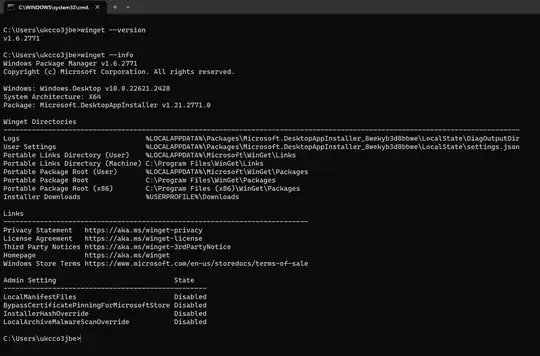Update 2023-04-17
It seems winget version v1.5.1081-preview and above (those including PR3128), include info on default directories by running winget --info.

There's also an open issue to be able to list the directories per app (Issue 2298).
Regarding Zotero itself, I couldn't find a package with ID Zotero.Zotero, but did find DigitalScholar.Zotero. That shows that the default installer's used, so the default path would be the same as the app's (from hunting around their docs this seems to be C:\Program Files (x86)\Zotero, though I've not seen anything explicit).
Note: It's possible that your additional version of Zotero.Zotero doesn't exist on disk; but only exists in WinGet's database (e.g. if it were installed then the path deleted without WinGet being aware). See "Failed Attempt to Hunt Out Metadata" for info on how to query that database).
Original Answer
The exact location depends on the package & so far as I can tell there's currently no way to fetch that info for all installed winget packages.
For those which don't have installers, but are just files downloaded, they're put under a folder under: %localappdata%\microsoft\winget\packages
Where there's an exe with a portable command alias (i.e. to avoid having to add each exe's path to your PATH variable), a symlink is created. That symlink is held in %localappdata%\Microsoft\WinGet\Links\.
Note: Some apps' manifests may specificy a default install directory. That's given in their InstallLocation property (see schema).
Failed Attempt to Hunt Out Metadata
I wondered if you could find the path under which WinGet stores the metadata of packages installed... I couldn't - but notes below in case this helps others hunt deeper (my conclusion is that WinGet doesn't remember where it installs things, only that it has installed them / what version it installed; everything else is left to the default installer).
You can get the path for its settings file by running winget settings then looking at the path of the settings.json file that this opens. For me this was: C:\Users\myUsername\AppData\Local\Packages\Microsoft.DesktopAppInstaller_8wekyb3d8bbwe\LocalState\settings.json
By poking around in that directory I found a SQLLite DB: C:\Users\myUsername\AppData\Local\Packages\Microsoft.DesktopAppInstaller_8wekyb3d8bbwe\LocalState\Microsoft.Winget.Source_8wekyb3d8bbwe\installed.db.
We can query this file/database using the below PowerShell:
# Load the System.Data.SQLite.dll assembly. This is likely already somewhere on your machine, but if you can't find it, see https://system.data.sqlite.org/index.html/doc/trunk/www/downloads.wiki
Add-Type -Path 'C:\Program Files\Microsoft Visual Studio\2022\Professional\Common7\IDE\PrivateAssemblies\System.Data.SQLite.dll'
Update this path with your install.db path
$installDbPath = 'C:\Users\myUsername\AppData\Local\Packages\Microsoft.DesktopAppInstaller_8wekyb3d8bbwe\LocalState\Microsoft.Winget.Source_8wekyb3d8bbwe\installed.db'
create a connection to this db
$con = [System.Data.SQLite.SQLiteConnection]::new("Data Source=$installDbPath")
$con.Open()
Create and execute a query to list all tables (thanks to https://stackoverflow.com/a/14623907/361842 for the SQL)
$command = $con.CreateCommand()
$command.CommandText = @"
SELECT name FROM sqlite_master
WHERE type IN ('table','view') AND name NOT LIKE 'sqlite_%'
UNION ALL
SELECT name FROM sqlite_temp_master
WHERE type IN ('table','view')
ORDER BY 1;
"@
$data = [System.Data.DataSet]::new()
$adapter = [System.Data.SQLite.SQLiteDataAdapter]::new($command)
$adapter.Fill($data) | Out-Null
$data.Tables.Rows
channels
commands
commands_map
ids
manifest
manifest_metadata
metadata
monikers
names
norm_names
norm_names_map
norm_publishers
norm_publishers_map
pathparts
pfns
pfns_map
productcodes
productcodes_map
tags
tags_map
versions
Now repeat over the IDs table to give the IDs of all installed packages
$command.CommandText = "SELECT * FROM ids"
$data = [System.Data.DataSet]::new() # reset this to avoid appending
$adapter.Fill($data) #note: adapter has a reference to $command, so by updating the command text the adapter's command is automatically updated
$data.Tables.Rows | ft -AutoSize
sadly I hunted through all the other tables but couldn't find any hint of an installation directory being stored here

